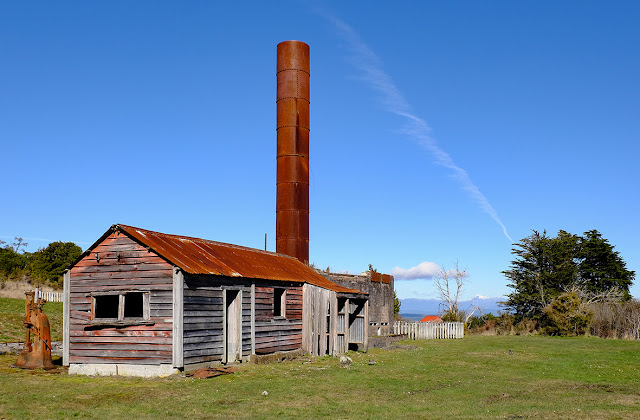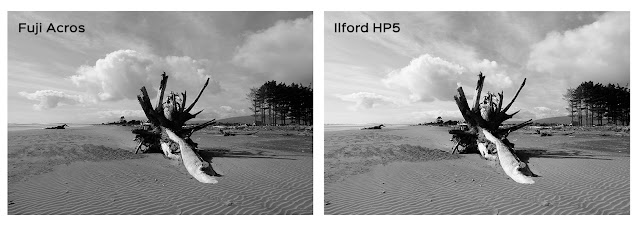Exploring a Ghost Town with the Fujifilm X-E2
Spring is in the air in New Zealand (as I write this), and the days are getting longer, brighter, and warmer. Sunday is our day of rest - not exactly a Sabbath day where nothing happens - but close enough. This Sunday we had invited some friends for lunch, but they had to cancel at the last minute. Since the day was beautiful and sunny, lunch was already prepared the day before, and we were now at a loss, my wife suggested we go somewhere and take a picnic lunch. Great idea, honey - and I know just the place. Waiuta.
 |
| Boiler House, Waiuta. Fujifilm X-E2. f/8 @ 1/680th, ISO 400. Ektachrome E100SW recipe |
Waiuta is now a Ghost Town, but was once a thriving Gold Mining Town for 45 years (from 1906 to 1951). If you love to photograph derelict old houses (like I do) then it's a photographers dream. I've visited a couple of times, but the last time was about 12 years ago, so I was long overdue for a return visit.
One of the main buildings that is still somewhat in-tact (due to some preservation efforts) is the Boiler Room that sat next to the poppet head (now long since gone). It makes a great subject, with the weathered wooden boards contrasting starkly against the rusted metal of the roof and boiler chimney. On a beautiful, clear, blue-sky day the colours practically pop off the screen, especially when using the E100SW film simulation recipe on the Fujifilm X-E2.
 |
| Bowling Club & Meeting House, Waiuta. f/8 @ 1/680th, ISO 400 |
A building that hasn't fared quite so well is the Bowling Club and Meeting House that resides just a stones-throw away from the Boiler House.
And yes, you heard correctly - Waiuta had a Bowling Club! In fact, it also had tennis courts, a dog racing track, and large swimming pool - as well as cricket and rugby teams. Other facilities included shops, post office, a hotel, hospital, school and churches (Catholic and Anglican). In its hay-day in the mid 1930s the population of the Waiuta Township peaked at over 600!
Waiuta grew to provide accommodation for miners who worked at the nearby Blackwater mine. A gold-bearing quartz reef was discovered by a prospecting party in 1905, and acquired by Consolidated Goldfields who developed the mine. From 1908 to 1951 this mine steadily produced gold from a steep, narrow quartz reef, providing 36% of the gold produced from the Reefton area.
Unfortunately, in 1951 the Blackwater shaft collapsed and filled with water. Several failed attempts were made to repair the mine, which still held gold deposits. Its closure meant the end of the town, since this was the only source of the towns employment. Within a few weeks many miners and their families had left the area. Most buildings were dismantled and carted away as there was a shortage of building materials. Within a few months Waiuta was almost a ghost town.
 |
| Gills Cottage restoration. f/5.6 @ 1/1700th, ISO 400 |
The area is now maintained by the Department of Conservation, although it seems to be fighting a loosing battle. While the tracks are reasonably well maintained, the same can't be said for many of the cottages and huts (most of which, however, are privately owned).
To try and rectify some of the inevitable disrepair, the 'Friends of Waiuta' formed to undertake some renovations. One such project is Gills Cottage, which is gradually being restored to its former glory - as funds allow.
Unfortunately, one historic dwelling that has probably now deteriorated beyond repair is the cottage of photographer Joseph Divis (1885-1967).
 |
| Joseph Divis' Cottage, 2020. f/5.6 @ 1/1800th, ISO 400 |
Most of the things we know about the town of Waiuta we know because of the photos of Joseph Divis. An experienced miner, Divis emigrated to New Zealand in 1909 from the Czech republic and supplemented his income by taking photographs. He traveled around different mining towns throughout his lifetime, but settled in Waiuta in 1930. In 1939 he was injured in the Blackwater Mine and never worked as a miner again. When the Blackwater Mine closed in 1951, Divis was one of the few residents who chose to remain living at Waiuta.
 |
| Joseph Divis' Cottage, 2008. |
As a fellow photographer, his story, and his legacy, really resonates with me. Which is why it was so sad to see his cottage in such a dismal state. As I mentioned earlier, it has been about 12 years since I have visited Waiuta. Back then I took a very similar photograph of Joseph Divis' Cottage (see left) in much better condition than the broken, battered and beaten shell of a building I visited this time around. I understand that time is not kind to buildings that are not maintained, and that it takes money and a willingness to do so. I also suspect that vandalism has had a part to play in the buildings sad state of affairs. But still. it was a shocking, and painful experience to see his cottage so badly neglected.
 |
| Rimu Cottage, Waiuta. f/8 @ 1/70th, ISO 400 |
Another historic building in a bad state of repair is Rimu Cottage. I guess this should be no great surprise. After all, the clue is in the name - Ghost Town. These buildings are no longer lived-in residences, so it's no big surprise to see them slowly decaying away. But it is sad, nonetheless. Sad, and eerily spooky. I guess they ain't called ghost towns for nothing!?
 |
| Blackwater School, 1913-1949. Fuji X-E2 f/5.6 @ 1/550th, ISO 400. E100SW film recipe |
On the way out from Waiuta is another historic old building - Blackwater School. It's in a slightly better state than many of the cottages in the Waiuta township, and is even being repaired in stages (again, when funds allow). You can go inside and have a look around, being careful not to go through some of the floorboards, and be transported back to a time of old wooden desks and ink wells. Our history is encapsulated in these old buildings. And as much as it's costly to maintain and preserve them, we loose a huge part of ourselves and our identity if we let them just rot away. It's difficult to preserve absolutely everything, I know. But can we really afford to let the past just rot away?
 |
| Old house, Ikamatua. Fujifilm X-E2 with XC16-50mm. f/8 @ 1/550th, ISO 200. |
Having just said all that, there's no doubt that derelict, neglected, falling-down houses make for great photographic subjects! On the way back home to Greymouth, you pass through the tiny settlement of Ikamatua (Ik-a-ma-too-a). Nestled on the top of a hill is a house that I have wanted to photograph for a very long time, but haven't - for one reason or another. Usually it's because the lighting isn't quite right, or simply because I'm in a hurry to get somewhere else. I've often driven past and though 'one day'. But have also often worried that 'one day' might never come. More than once I've seen some derelict building or machinery that I've thought I would photograph 'one-day', only to discover that the building is torn down, or the machinery moved.
So this time, with lovely afternoon light, and beautiful blue skies with puffy white clouds, I was determined to 'get the shot'. And I'm very glad that I did. I love it, and it's my favourite shot of the day - even though it wasn't taken at Waiuta!
 |
| Waiuta selfie. A couple of old relics! |
And if nothing else, you will probably come away from Waiuta realising how lucky we are to live the modern, luxurious lives that we are privileged to have in the 21st Century.



Comments
Post a Comment